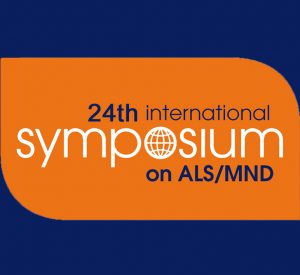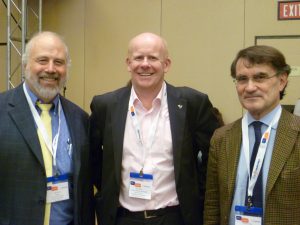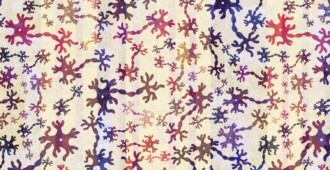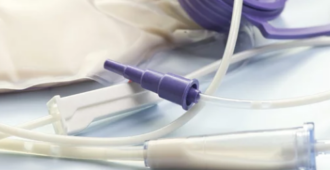The International Symposium on ALS/MND is the largest MND-specific

conference in the world, which is expected to attract over 900 delegates this year. The planning of the Symposium is a year long event and is pretty much like organising a film premiere, with a number of different teams involved. The ‘symposium team’ ranges from the Conference team to volunteers at the host Association, and from the programme committee to the Research team.
Louise Hough (Communications and Information Assistant at the MND Association) asked us a number of questions about the symposium. We thought you’d be interested in the answers too which we’ve posted below.
Not quite a shopping holiday..
For starters, we’re not all jetting off to Milan for a bit of pre-Christmas shopping! Delegates and organisers alike will be pretty much ‘hotel-bound’ and are likely to only see Milan through the windows of a taxi to-and-from the airport.
- Belinda and I will be too busy with our noses in our laptops typing away all of the exciting MND research news discussed during the symposium and reporting it back to you LIVE through this blog! Naturally, we’ll also be ‘tweeting’ throughout the conference with highlights from the presentations. So, get on Twitter today and follow what’s being discussed LIVE.
- The Research team will also organise the two poster session during the symposium. These posters are not what you might expect, and are in fact a visual representation of an abstract. The biggest challenge this year for us will be the ‘swap over’ from one poster session to the next on the second day!
- Dr Brian Dickie, our Director of Research Development, and his PA Pauline Frear will also be attending this year’s event. They will be liaising with key symposium presenters, planning for next year and making sure the symposium runs smoothly from start to finish.
Why do we organise the symposium?
With over 900 leading scientists and clinicians from around the world uniting to hear and discuss the latest developments in MND research the symposium is the ‘blockbuster’ of the year.
The symposium makes us different from other MND research funders and is our ‘unique selling point’. The symposium helps showcase MND research from around the world and improve care practice in MND. By organising the symposium we ensure that we are up to date with what’s happening internationally in MND research, which keeps us at the forefront of working towards a world free of MND.
The symposium is also a platform for other smaller, specialist ‘business type meetings’ to take place – enabling people in the same field to catch up so to speak. For example, this year there is a meeting on DNA testing in MND. These smaller meetings are like the popcorn and ice cream sellers at the cinema, all connected to the film in their own specialist way.
Who can attend?
The symposium is fundamentally aimed at researchers, healthcare professionals and clinicians ‘a specialist audience’. Some of the healthcare professionals in attendance include many UK MND care centre co-ordinators, as part of their continuing personal development.
Association staff members attending include: the Conference team (to help organise registration and other logistics), the Research team (to report from the symposium, liaise with presenters and organise the posters), Sally Light, our CEO, along with support from the Communications team.
Steve Bell, our Director of Care (North), also attends the symposium and co-organises the Allied Professionals Forum (APF). This specialist meeting for health and social care professionals occurs the day before the symposium. The mission statement of the meeting is for delegates to foster the exchange of information about good practice and facilitate the highest standard of care for people with MND and their carers.
Are people living with MND able to attend?
People living with MND can and do attend, but the symposium is principally aimed at specialist MND researchers. The symposium is focused on working for the future and present needs of people living with MND through showcasing new scientific ideas and exchanging expert knowledge from around the world.
For those without specialist knowledge the symposium can be incredibly complex, our job is to attend and translate this. This way we are giving people living with MND a real insight into what is going on in the world of MND research – hopefully without too much of the science jargon!
The Annual Meeting of the International Alliance on 3-4 December is a specialist meeting for people living with MND that occurs before the start of the symposium. This is the only opportunity for an international group of people living with MND to get together every year. If you would like to register for this meeting see the International Alliance of ALS/MND Association’s website for details.
Why is it not held in the UK?

The first symposium was ‘born’ in the UK in 1990 when a group of 50 researchers held a meeting in Birmingham. Since then the symposium has grown in both size and quality to become the world’s premier meeting on MND. In order to attract an international audience and invite local experts to speak the location changes each year. Last year it was in Chicago and in 2011 it was in Sydney.
Why is the symposium on such a large scale?
In principle, a large number of people around the world have an interest in MND research and care practice – this is why the symposium is so big! Also, the more researchers attending the meeting, the more opportunity there is to exchange new ideas and form more partnerships, thus helping us on our way towards a world free of MND!
What is an ‘abstract’?
An ‘abstract’ is basically a summary of a piece of work to give the reader a ‘taste’ of what’s to come – like a ‘scientific trailer for a movie’. These summaries contain a brief introduction, results and conclusion to give the reader an idea of the research – but not the whole detailed story!
What is a ‘poster’?
Unlike your typical cinema poster, which usually consists of a big image and a release date, a scientific or clinical poster is a detailed visual representation of the research carried out and allows presenters to discuss their work with delegates in detail. They usually contain pretty graphs and cell images, which show visually what the researchers have found. Examples of posters can be seen here.
What information is available for those who cannot go?
All of the abstracts from the symposium are published by means of Open Access from the 4 November. This means those who cannot attend can still get an idea of what’s going to be discussed, from clinical trials to genetics.
You can keep up to date on Twitter using the hashtag #alssymp. We will also be reporting from the event via this blog for a general audience. Delegates (people attending the conference such as scientists and clinicians) will be reporting from our peer-to-peer blog known as ReCCoB for a more technical audience.
Final thoughts
Like organising a film premiere us, the Conference team and all the volunteers put in an incredible amount of hard work and effort into organising the symposium; from picking the hotel to the abstract proof reading and LIVE reporting.
Even though there is still a lot left to do, I am looking forward to attending my first symposium and letting you know about all the exciting MND research discussed in Milan!
So, now you know that it really isn’t about the shopping but all about the science!





